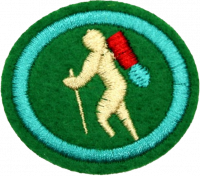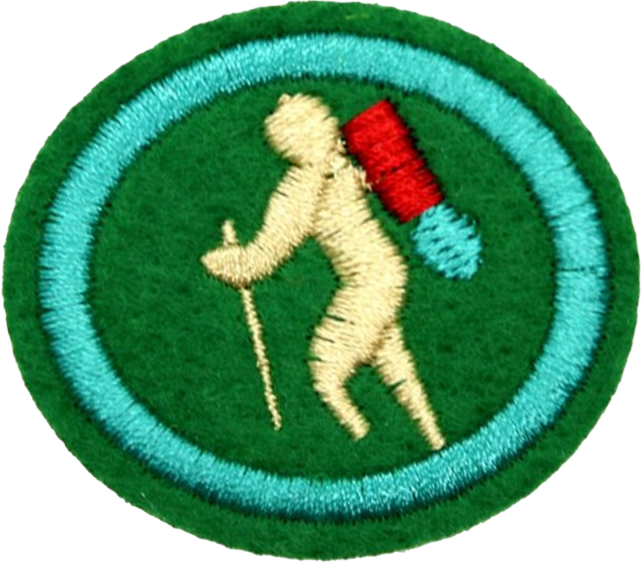Especialidades JA/Excursionismo pedestre com mochila/Repostas
Nível de Habilidade
2
Ano
1986
Version
20.12.2025
Autoridade de Aprovação
Conferência Geral
1
2
3
There are a lot of products on the market these days that are called "backpacks," but don't be fooled. Some of them are entirely unsuited to backpacking. Most of the cheap ones you will find in a store are intended for carrying school supplies between the house, school bus, and classroom. They are not designed to carry all the gear you'll need for an overnight trip over miles of rough terrain. A backpack suited for backpacking will have a hip strap on it that fastens around the hips. Most of the weight of the backpack will thus be carried on your hips. The shoulder straps will carry a small percentage of the weight as well, but they are really intended to keep the backpack from tipping off. If you find that you are carrying most the weight on your shoulders, you need to adjust the backpack to shift the weight to your hips. You will be able to walk much farther distances in greater comfort that way.
4
- Good quality map of the area
- Compass
- Knife
- Flashlight
- Water treatment equipment
- Water bottle
- Food
- Change of clothes
- First aid kit
- Rain gear
- Backpack
- Firelighting equipment
- Sleeping bag
- Sleeping pad
- Extra socks
- Good quality hiking boots or hiking shoes
- Eating and cooking utensils
- Cooking gear (mess kit)
- Backpacking stove and fuel
- Tent or tarp
- Toiletries (toothbrush, toilet paper, soap, etc.)
- Compact shovel
5
6
- Lay out all your gear where you can see it, next to your pack.
- Look for empty spaces in your gear - for instance, there may be room inside your cooking pot. Put any small items that will fit inside that to conserve space. Look for other "hidden" space as well.
- For an internal frame backpack, put the sleeping bag in first, at the bottom. For an external frame, tie it underneath the pack.
- Load the heavy items next, placing them as close to your back as you can. This will shift the center of gravity forward which will help your balance and improve comfort. Be sure nothing is going to poke you in the back though.
- Put the lighter items such as clothing in towards the outside of the pack.
- Put the things you'll need on the trail (like water, trail mix, compass, map, etc.) in the outer pockets where you can get to them. If they're hard to get to, you'll be unlikely to use them. And if you don't use them, why bring them at all?
7
Dos alimentos do item anterior, quais são encontrados em supermercados? Faça o seguinte:
The best type of food to take backpacking is dehydrated food, as it is very lightweight, compact, and nutritious. You can buy food pre-packaged or you can dehydrate it yourself. For details on dehydrating your own food, see the Food Drying honor in the Household Arts section of this book.
7a
7b
7c
8
8a
8b
8c
8d
8e
8f
8g
8h
8i
9
Compact, lightweight firsts aid kits are available at many retailers and outdoor outfitters. But don't just go out, buy one, and toss it in you pack without another thought. It is important for you to open it up and examine every item. Then review the answers for the First Aid honor, so that you know how to use each item.
10
An adult should carry no more than a fifth to a third of his or her body weight in a backpack, depending on the level of fitness. A kid should not carry more than a quarter his body weight.
Your aim should not be to load your pack until you hit the maximum, but rather, to bring as little as you can get by with. But don't carry anything you aren't going to need. When it comes to backpacking, less is more! Don't kill yourself. Evaluate every item you put into your backpack. Little things add up quickly, so try not to duplicate functionality. For instance, if you're brining a pocket knife, you can probably leave the butter knife behind. Bring a spork rather than a spoon and a fork. Use parachute cord for a clothesline - it's very strong and can be used as rope. Distribute "group" gear among the group. Take the tent apart and have one person carry the fly, another the canopy, and a third the poles. Instead of bringing a pillow, stuff tomorrow's clothes into a sack and use that.
11
Northern hemisphere instructions
Southern hemisphere instructions
Southern Cross to find south at night
With the lack of a significant pole star in the southern sky (Sigma Octantis is closest to the pole, but is too faint to be useful for the purpose), two of the stars of Crux (Alpha and Gamma, Acrux and Gacrux respectively) are commonly used to mark south. Following the line defined by the two stars for approximately 4.5 times the distance between them leads to a point close to the Southern Celestial Pole.
Alternatively, if a line is constructed perpendicularly between Alpha Centauri and Beta Centauri, the point where the above line and this line intersect marks the Southern Celestial Pole. The two stars are often referred to as the "Pointer Stars" or "White Pointers", allowing people to easily find the top of Crux.
The junction of these two lines is the SCP Southern Celestial Pole. If you were at the South Pole this would be directly above you. This is the point where the night sky revolves around. Point to this spot then lower your arm to the horizon. Where you are pointing is South.
Watch method
Southern Hemisphere method only.Point the 12 to the sun. Halfway between the hour hand and the 12 is North. You still have to use your intelligence for this as early morning time and evening time care must be taken as to which half you use. E.g. 8am sun is rising in the East; point 12 to the sun North is halfway between the 8 and the 12 at the 10. BUT late evening the sun is heading to set in the west say time is 8pm you point the 12 at the sun. North is halfway between the 8 and the 12 at the other side of watch at the 4. This should be used only as a guide as in some countries the real time has been adjusted and sometimes there is daylight saving time etc.
Stick method
This method is a waste of time. We all know the sun rises in the East and sets in the West. The stick shadow shows you this. Also when the sun is at its zenith the highest it gets in the Southern Hemi look at the sun and it is towards the North the opposite in the Northern Hemi. So we learn that at mid day is the best time to find North (or South).
But if you must... place a stick in the ground on an open area. Mark the shadows at times through out the day. From this you can find North or South (depending what side of the equator you are on) from the shortest shadow and also East and West by drawing a line from the ends of the longest shadows assuming you had an early morning and late evening marking with equal time from mid-day. But for this you have to be lucky to have sunshine for most of the day, which usually is not the case if you are lost. Anyhow it is something to know if you do not have a watch to know when mid-day is.
12
- Alone
- Set the backpack on a table (or a large rock), put your arms through the straps (loosened off), and lift with your legs. You can also set it on a rock or a log and sit down in front of it. Again, lift with your legs, not with your back. If there is nothing available to set your pack on; stand with your feet apart, one leg ahead of the other, knee bent enough to set your pack on it. With shoulder straps loosened off, slip one arm through the shoulder strap, lean into your pack and slightly downward, and roll it up onto your back. Once in place, slide your other arm through the shoulder strap. Always tighten your hip belt first, shoulder straps next and lastly your chest strap. Reverse this procedure for removing your pack.
- With a Partner
- Have your partner lift your pack and hold it while you slip your arms into the straps. If you have to stoop, bend your knees. Remember to lift with your legs!
13
Five miles is a good backpacking trip for a beginner. Find a trail near you by visiting your local outdoor outfitter. These stores are most often staffed by people who enjoy backpacking and can provide you with valuable advice on destinations. Once you've got a 5-mile trip under your belt, why not look at the Pioneering honor and make your next trip a 15-miler? If you make it a 15-mile hike, you can also count this backpack trip toward the hardest requirement of the Hiking Honor.
References
- http://www.patc.net/hiking/gear/packs.html
- http://gorp.away.com/gorp/eclectic/family/expert/ask_exp.htm


